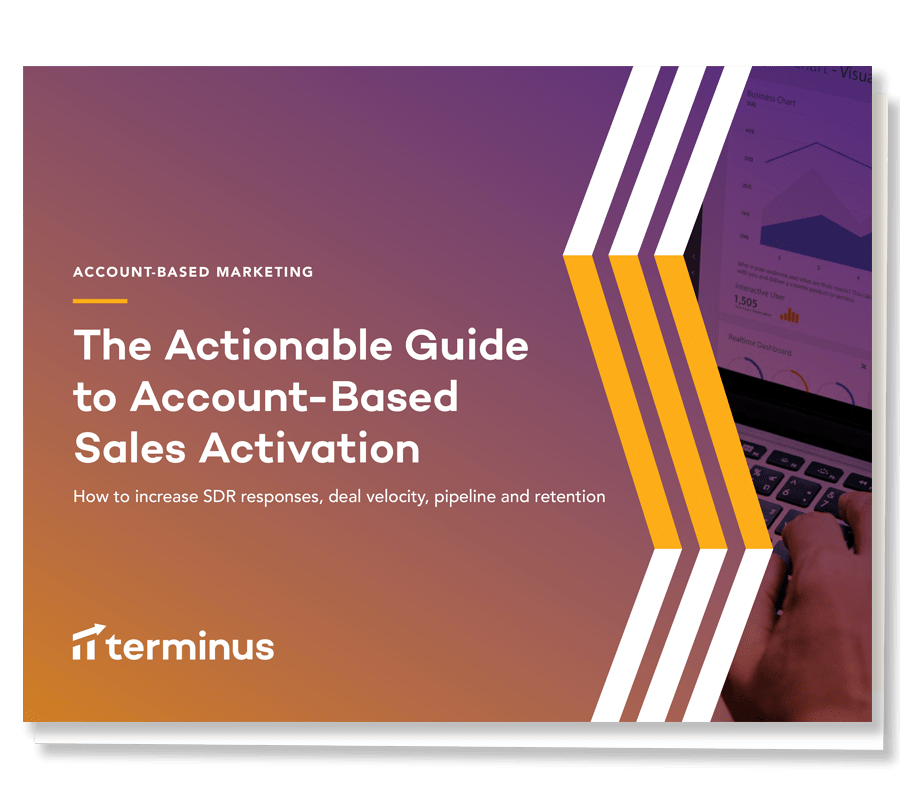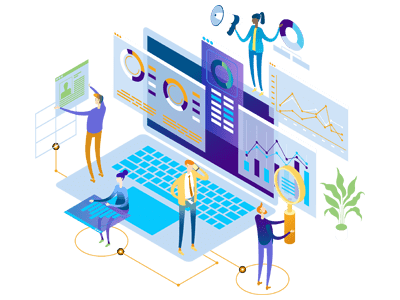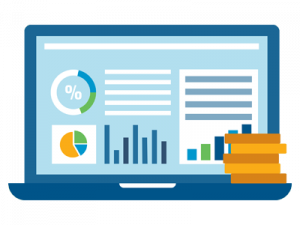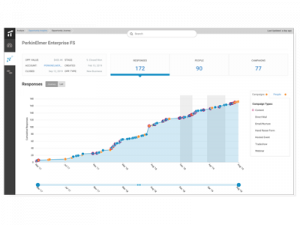Infographic: The Account Based Sales & Marketing Funnel
Find the right audiences, get relevant messages in front of them across every channel, measure performance on key metrics, and stay aligned through the entire revenue journey. Here’s a layout of how teams today win with account based sales & marketing.


Terminus: Everything You Need in an Account Based Platform (And More)
Give your sales team the air cover and data they need to progress and win more deals. See why over 1,000 customers have made Terminus the #1 account based sales & marketing platform on the planet.

Why Sales Teams Love an ABM Strategy
learn more
How Account-Based Sales Teams Today Use Terminus
READ MORE
Strategic Account-Based Deal Coaching for Sales Leaders & Sellers
learn moreAccount Based Sales
Let’s go over a brief history of account based marketing, long before there were popular ABM platforms like Engagio, HubSpot, and Terminus. The earliest account based marketing examples probably started thousands of years ago, but let’s instead use a very simple example: door-to-door vacuum sales. Door-to-door vacuum sales were account based sales. To secure a sale, salesmen went from person to person, connecting with them face-to-face, and physically giving them a demonstration.
For a long time, this is what salesmanship was. People talked to a salesman directly. The salesman fostered a relationship. When someone needed a tool, they didn’t just look up tools online. They went to their hardware store and asked the salesperson, whom they knew intimately, what was the best for their job.
Today, ABS sales are a little different. Most of our marketing is done online. And for the better part of the last decade, online marketers struggled to implement ABM sales. That’s because an account based marketing platform hadn’t been released yet that could really transition that type of one-on-one interpersonal relationship to the digital era.
Currently, someone can get an Engagio login and start engaging with a multitude of customers in a scalable fashion. They can look up account based marketing Hubspot articles and start personalizing and automating their emails. And though Engagio pricing may not fit everyone’s budget, there are enough Engagio competitors with a similar Engagio valuation that there are a lot of account based marketing solutions to choose from. Engagio, and others, have a lot to offer in terms of being able to improve upon sales and marketing departments.
ABM is rapidly becoming a standard for marketers because the technology has finally become efficient enough. But the technology is necessary. Terminus provides a wealth of case studies, examples, workbooks, and, of course, the Terminus platform. Because ABM isn’t only a marketing thing; it’s an everyone thing. The leadership team, marketing team, sales team, and more, all need to be able to work together. All teams that drive revenue need to be connected to an ABM strategy, and Terminus can help.
Targeted Accounts
If you want to implement ABM processes, you get started with targeted accounts. It’s the first and most important step in an account based marketing framework or strategy. As you begin your account based planning, you need to consider how to fine-tune and optimize your processes. A lot of this has to do with identifying and scoring leads, and developing the ideal customer profile.
Marketing and sales teams need to evaluate their best customers: their traits, characteristics, and more. From there, they can identify like-kind audiences that have a lot of similarities with their current customer base.
This type of analysis is important, because a company doesn’t always know its own ideal demographics, or its own realistic demographics. An account targeting sales strategy has to be grounded in data. And industries will vary; pharmaceutical selling models will differ from eCommerce, and account based selling pharma companies are going to differ from home improvement stores. To a certain extent, companies need to research their own industry; a key account management in pharmaceutical industry PPT is going to tell companies more about what they need to know regarding KAM pharma.
Each industry is going to adopt an ABM strategy that works best for them; there isn’t a one-size-fits-all approach to a named account sales strategy or target account analysis. When it comes to KAM pharma, pharmaceutical companies may be able to recognize there are certain areas in which their medications are needed more, or certain profiles for doctors or hospitals that are more likely to make a purchase. They may also notice that there are certain patients who are more likely to be interested in the medications, and more receptive to direct marketing.
And the next step is simple. Once these targeted accounts have been analyzed, then the true work can begin. The company can start developing connections and moments of contact with these individuals, so they can better promote their services and products, and so they can better serve their customer base.
Account Names
Once a company is able to score its accounts, it can then create tiers of accounts. But a company also needs to know how to tier accounts and how to make a target list. Tiering accounts has to do with scoring account names, and it’s a critical part of the account based everything ecosystem. It’s one of the first things that will be discussed on an account based marketing PPT and for target account selling strategies.
It begins by having an entire, prioritized list of account names. From there, separate them to the accounts who are most likely to make a purchase, and most likely to have a high lifetime value. In terms of the Pareto Principle, or 80/20 rule, it’s going to be the 20 percent of clients that make up 80 percent of your business. After that, select the clients who are your bread-and-butter: They aren’t the biggest, but they’re consistent.
Eventually, you should have a list of all your prospective clients, by order of how likely they are to buy, and how valuable they will be to the company. This lets you allocate your energy most effectively, because you can focus almost all your energy at the highest value accounts. Of course, you still need to pay attention to accounts that may not be as high up; that’s just part of good business and part of good customer service. Any scoring model also isn’t going to be entirely accurate, and you may find that your perception of the situation (and the scoring) changes after some customer interactions.
Related to this, you might also want to consider how many accounts should a sales rep have. This is often based on time and industry. In companies that have high volume, important sales, such as pharmaceuticals, there may be fewer accounts but more important accounts. In companies such as eCommerce companies, sales reps may need to juggle dozens if not hundreds of accounts, but interaction will be rare.
Account Based Selling
While it may seem counterintuitive, account based marketing isn’t all about selling. A good deal about it is customer service, too. And that’s something that someone needs to know to engage in sales IO as a sales hacker. The account based selling framework, account based marketing plays, and account based marketing workbook will all show you that it’s important to provide best-in-class customer service. Named target marketing under account based selling is, at its core, about making sure that everyone gets what they want.
Account based selling begins with a thorough understanding of the customer, so that the sales professional can meet their needs. That involves data collection, communication, and interaction. With the right templates and sales questions, sales professionals can start to drill down to needs and pain points. They can then match those needs and pain points up with products and services.
An account management sales hacker can provide “air cover” for targeted accounts with targeted ads, field marketing, web personalization, chat, and more. All these sales tactics are designed to ensure that customers know what products and services are available, and that they are presented with the options that are most appealing to them. Sales hacker account based marketing is most effective because no one is fighting the customer. Instead, the customer is being given what they need.
Sales hacker account based selling will focus on building relationships, selling value to key stakeholders, and ultimately making sure the sales cycle is progressing. At every step of the way, the sales professional will make sure that customers are still happy, and that they are getting the value that they deserve. The Sales Hacker venue is a good source for ideas and selling advice, if sales teams need additional resources about how to make the most out of their account based selling.
Account Based Engagement
In account based engagement, engagement covers pretty much any type of interaction someone has with a brand during the lead generation process. During lead generation and lead acquisition, customers might click on links, read newsletters, fill their cart on a website, and more. Sophisticated lead generation techniques take into account the activities that the customer engages in, and finds ways to further involve them. For example, customers who fill their cart on a website might get a follow up email.
Lead acquisition is often about following the customer’s interactions and prompting them to communicate more. Studies have shown that the more interaction customers have with a brand, the more likely they are to trust it, and consequently the more likely they are to commit to a purchase.
Naturally, types of lead generation will vary based on industry. B2B sales, for instance, have a far lengthier and more complex lead generation process, whereas lead based sales for eCommerce companies are largely automated. Regardless, platforms like on24 engagement tools can help.
When it comes to account based marketing vs lead generation, it needs to be considered that there is a lot of overlap, but the differences are vitally important. Both involve connecting with clients. But lead generation tactics tend to be very general, with a “spray and pray” ethos. For instance, cold calling thousands of people, or sending out email blasts to purchased account lists. This type of lead generation can still be useful in terms of quantity over quality, but it isn’t ABM. With ABM, marketing is personalized, unique, and one-on-one, even when it’s automated. ABM focuses on narrowing the marketer’s efforts to what is most likely to be fruitful.
Not all companies need ABM over standard lead generation. But many companies that attract high value clients (or even mid-level customer lifetime values) will see extraordinary benefits. It depends on whether customer retention is important to the business, and whether customer satisfaction strongly influences the company. If a company has a lot of one off customers who never come back, then it may not care too much about ABM. If a company needs to sell products and services to a smaller number of high value customers, ABM is absolutely essential.